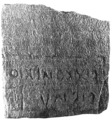VB·22: Difference between revisions
From Lexicon Leponticum
Jump to navigationJump to search
No edit summary |
No edit summary |
||
| Line 26: | Line 26: | ||
|source_detail=Morandi 2004: 563 f. no. 65 | |source_detail=Morandi 2004: 563 f. no. 65 | ||
|checklevel=3 | |checklevel=3 | ||
|problem=original script | |problem=original script, palaeographical datings on the inscription pages! | ||
}} | }} | ||
== Commentary == | == Commentary == | ||
| Line 33: | Line 33: | ||
Images in '''{{bib|De Giuli 1979}}: 246 (photo and drawing)''', {{bib|Tibiletti Bruno 1979}}: 255, fig. 1 (drawing). | Images in '''{{bib|De Giuli 1979}}: 246 (photo and drawing)''', {{bib|Tibiletti Bruno 1979}}: 255, fig. 1 (drawing). | ||
{{bib|Tibiletti Bruno 1979}}: 253–257 (254 f.) considers the name formula inverted, with the individual name {{w||pianu}} in line 2, the patronym in {{m||-(i)i̯-}} {{w||aśkonetio}} in line 1 (comparing [[VB·28]] {{w||namu}} {{w||esopnio}} from nearby [[Levo]]; thus also {{bib|Tibiletti Bruno 1981}}: 166 f., no. 14, {{bib|Markey & Mees 2003}}: 139). Alternatively, {{w||pianu}} can be interpreted as a patronym in -''ū'', as per {{bib|De Hoz 1990}}: 323 f. and {{bib|Lejeune 1971}}: 53 (see [[The Cisalpine Celtic Languages]]); thus {{bib|Solinas 1995}}: 372, no. 120, critical {{bib|Eska 1995}}: 43 β. | {{bib|Tibiletti Bruno 1979}}: 253–257 (254 f.) considers the name formula inverted, with the individual name {{w||pianu}} in line 2, the patronym in {{m||-(i)i̯-}} {{w||aśkonetio}} in line 1 (comparing [[VB·28]] {{w||namu}} {{w||esopnio}} from nearby [[Levo]]; thus also {{bib|Tibiletti Bruno 1981}}: 166 f., no. 14, {{bib|Markey & Mees 2003}}: 139, {{bib|Morandi 2004}}: 564). Alternatively, {{w||pianu}} can be interpreted as a patronym in -''ū'', as per {{bib|De Hoz 1990}}: 323 f. and {{bib|Lejeune 1971}}: 53 (see [[The Cisalpine Celtic Languages]]); thus {{bib|Solinas 1995}}: 372, no. 120, critical {{bib|Eska 1995}}: 43 β. | ||
See also {{bib|Tibiletti Bruno 1978c}}: 24 f. | See also {{bib|Tibiletti Bruno 1978c}}: 24 f. | ||
{{bibliography}} | {{bibliography}} | ||
Revision as of 22:31, 4 April 2024
| Inscription | |
|---|---|
| Reading in transliteration: | aśkonetio / pianu |
| Reading in original script: | |
|
| |
| Object: | VB·22 Stresa (stela) |
| Position: | front |
| Orientation: | 0° |
| Frame: | |
| Direction of writing: | sinistroverse |
| Script: | North Italic script (Lepontic alphabet) |
| Number of letters: | 14 |
| Number of words: | 2 |
| Number of lines: | 2 |
| Workmanship: | carved |
| Condition: | complete |
|
| |
| Archaeological culture: | La Tène D [from object] |
| Date of inscription: | 1st c. BC [from object] |
|
| |
| Type: | funerary |
| Language: | Celtic |
| Meaning: | 'Pianu the Adgonnetian' or 'Adgonnetio the Pianan' |
|
| |
| Alternative sigla: | Tibiletti Bruno 1981: 14 Solinas 1995: 120 Morandi 2004: 65 |
|
| |
| Sources: | Morandi 2004: 563 f. no. 65 |
Images
Commentary
First published in De Giuli 1979: 248.
Images in De Giuli 1979: 246 (photo and drawing), Tibiletti Bruno 1979: 255, fig. 1 (drawing).
Tibiletti Bruno 1979: 253–257 (254 f.) considers the name formula inverted, with the individual name pianu in line 2, the patronym in -(i)i̯- aśkonetio in line 1 (comparing VB·28 namu esopnio from nearby Levo; thus also Tibiletti Bruno 1981: 166 f., no. 14, Markey & Mees 2003: 139, Morandi 2004: 564). Alternatively, pianu can be interpreted as a patronym in -ū, as per De Hoz 1990: 323 f. and Lejeune 1971: 53 (see The Cisalpine Celtic Languages); thus Solinas 1995: 372, no. 120, critical Eska 1995: 43 β.
See also Tibiletti Bruno 1978c: 24 f.
Bibliography
| De Giuli 1979 | Alberto De Giuli, "Le stele funerarie di Brisino", Sibrium 14 (1978–1979), 245–252. |
|---|---|
| De Hoz 1990 | Javier de Hoz, "El genitivo celtico de los temas en -o-", in: Francisco Villar (ed.), Studia indogermanica et palaeohispanica in honorem Antonio Tovar et Luis Michelena, Salamanca: Ediciones Universidad de Salamanca 1990, 315–329. |
| Eska 1995 | Joseph F. Eska, "Observations on the thematic genitive singular in Lepontic and Hispano-Celtic", in: Joseph F. Eska, R. Geraint Gruffydd, Nicolas Jacobs (eds), Hispano-Gallo-Brittonica. Essays in honour of Professor D. Ellis Evans on the occasion of his sixty-fifth birthday, Cardiff: University of Wales Press 1995, 33–46. |

